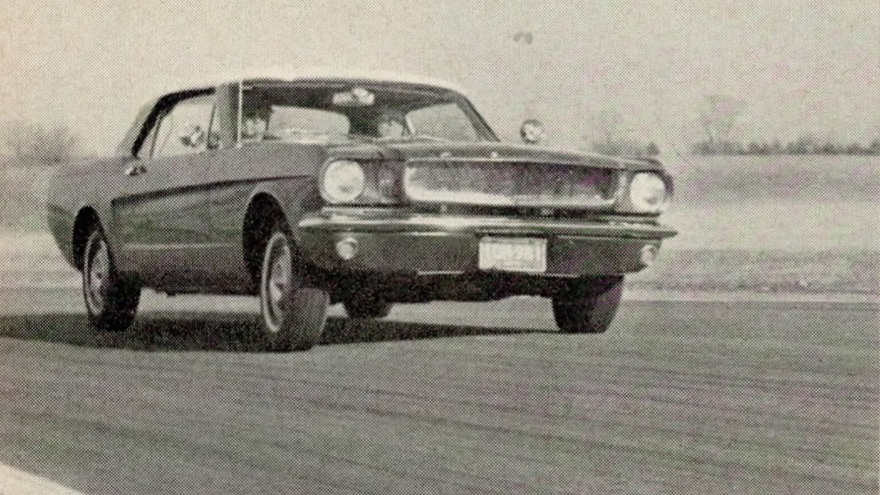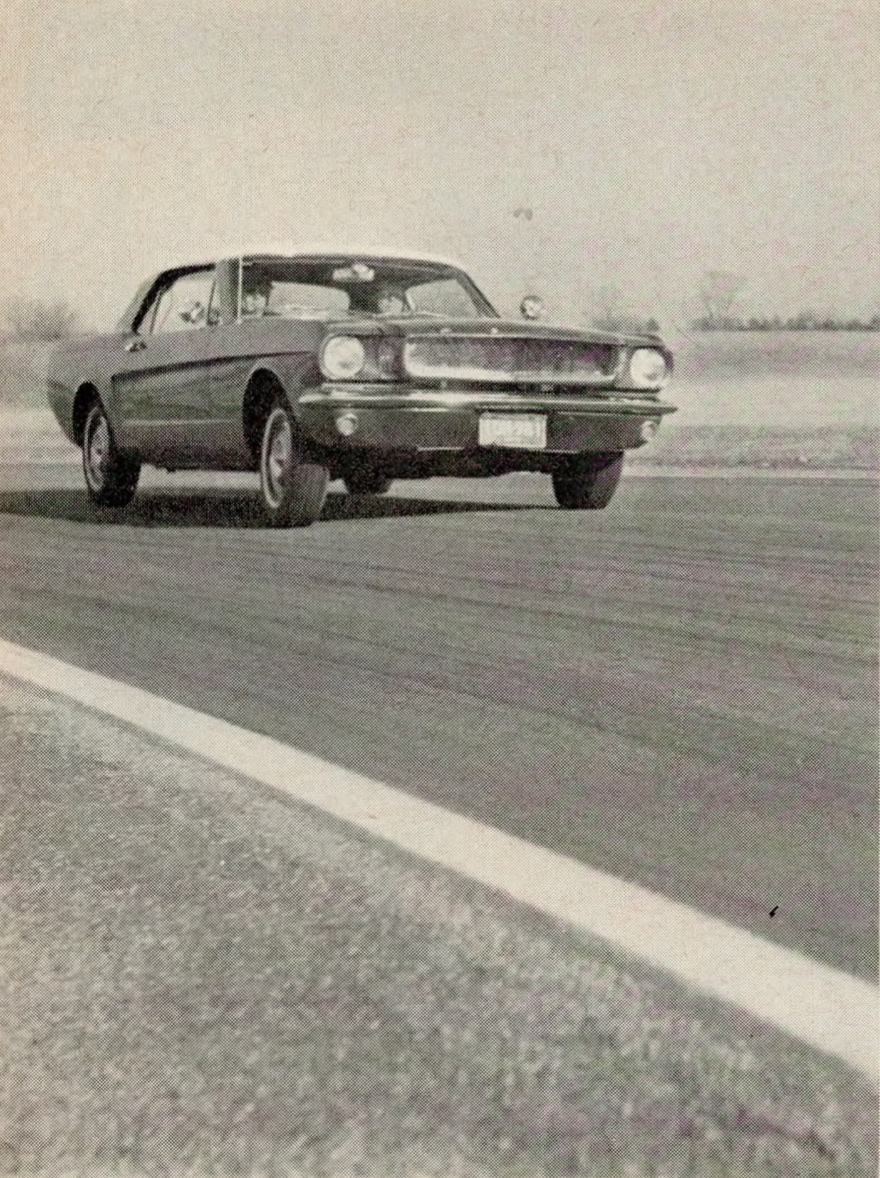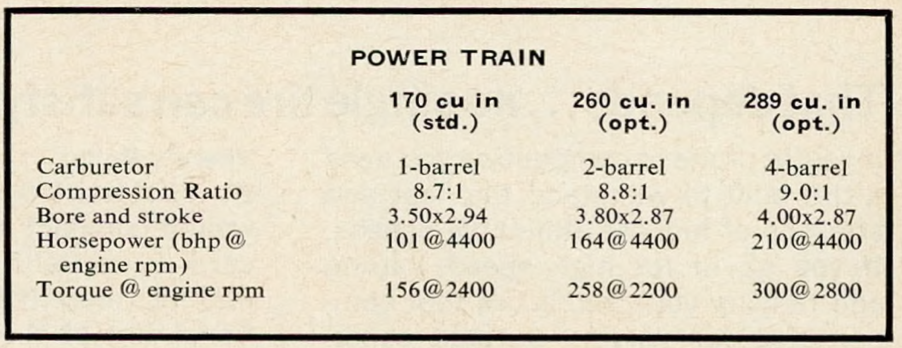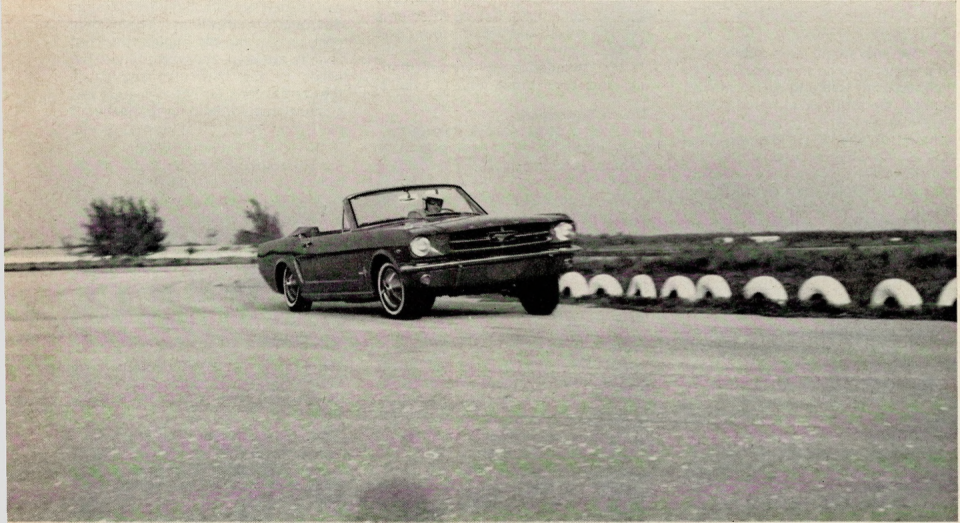From the Archives: Meet the Mustang


It should be noted at the outset that the Mustang is not simply a special-bodied Falcon, on the order of a Ghia VW, even though a casual glance at the specifications would lead one to that conclusion. There are significant changes in the suspension, in chassis and body strength, in driving position— all of which add up to an important difference in ride and handling. Those familiar with the characteristics of the Fairlane or Comet Caliente will find the Mustang much the same, yet much better.
This story originally appeared in the May 1964 issue of Road & Track.

Despite its long hood and engine setback, there is a front-end weight bias ranging from 55 to 58 percent, depending on engine/transmission combination and body style. Such a factor may tend to put one off, but the fact remains that the driving— particularly at speed— shows no adverse effect from this. At more moderate about-town speeds, the car does have a tendency to plow at the front but seldom does this cause the driver as much concern as, say, any other Ford product.
Such understeer all but disappears, however, as the speed increases. The Mustang seems to lift its nose and charge around the bends in easily controlled drifts, kept in hand as much by the throttle as by the steering wheel. Body lean, unlike the Falcon, is minimal and the underpinnings are well damped to eliminate the spongy porpoising which is all too common with domestic cars. Even with standard suspension components, the spring rates provide admirable firmness without undue harshness.
Wheel hop was never a problem, even on some of the diabolically designed rough surfaced roads at Ford’s Dearborn proving grounds where we drove the cars, but the sounds of strenuous suspension workings (hardly uncommon with unitized structures) provided constant companionship. It would seem that the special handling package, which greatly stiffens up the suspension, is hardly called for when the car is used for most normal service.
In this vein, Ford engineers tested one of the special-handling-equipped Mustangs (with soon-to-be 271 bhp engine) at the short, twisty 1.5-mi Waterford Hills, Mich., road circuit. They reported it lapped within 0.6 sec of the lap record (owned, incidentally, by a none-too-fast Cobra) even before any chassis tuning was attempted.

As expected, the braking and steering proved to be the Mustang’s Achilles heel. Deceleration rates on various cars, in all-out stops from 80 mph, registered in the neighborhood of 21 ft/sec/sec, hardly on par with any imported sports car. There was a slight tendency for the rear wheels to lock up, but brake fade seemed less of a problem than usual with domestic cars. The steering, power-assisted as was the brakes, was quite precise but required too much twisting of the wheel (3.8 turns between locks) for cornering comfort.
These drawbacks are compensated for somewhat in the layout of the driver’s compartment, which is much improved over that in the Falcon Sprint. The steering wheel, of Ford deep-dish design, reaches a bit too far toward the driver, but a flatter “sports” wheel is in the offing and should eliminate this one bother. Footroom is quite generous and seat adjustment range should accommodate all but the longest-waisted of drivers. The bucket seats give excellent lateral support and should be quite comfortable for even extended touring.
There is no question that the 289-cu-in. engines are excellent performers, although the figures we obtained (see chart) are a bit conservative. With the 271-bhp engine, capable of operating freely in excess of 5000 rpm, there undoubtedly will be Mustangs stampeding Sting Rays. The 210-bhp 289, however, obviously produces enough urge (15.9 lb/bhp with the test convertible) to satisfy a vast number of non-racing customers.
Even the thinwall 260 engine, hampered as it was with an air conditioner siphoning off horsepower, performed in quite respectable fashion for the average suburbanite. It has the advantage, moreover, of somewhat greater fuel economy by virtue of its single 2-barrel carburetion.

Where the engineers managed to fully Total the Performance, however, was with the Six, an engine which is all but anemic in the Falcon. The reason for the improvement apparently is the 3-speed automatic instead of the usual 2-speed Ford-O-Matic, resulting in a happy combination of gearing to torque curve to give the basic car a surprising spurt from the stop lights. “We could have stopped with the 6-cyl engine,” said Jack Prendergast, Ford’s Executive Engineer, “if all it had to do was compete with the Monza as a car for women and a second car.”
The interesting thing about Mustang V-8s, of course, is that a vast array of Cobra speed equipment can readily be bolted on for more exciting performance. With the special handling suspension option and 15-in. Super Sports tires, combined with the sturdiness of the frame to accommodate such thrust, the Mustang could certainly challenge the all round performance of almost any sports car.
As so often is true of Detroit products, there are aspects of the Mustang we felt should have had more thought—particularly because it was ostensibly designed for the enthusiast market. Long as the option list is, it stops short of some very desirable additions: aluminum or magnesium competition wheels, genuine snap-open fuel filler cap, roll bars, and reclining seats to mention a few. And there really isn’t any excuse for delaying the availability of disc brakes, even though corporate management balks at making them standard equipment.
Pricing is yet to be announced, as of this writing, but it plays a significant part on overall assessment of the Mustang. The only hint is that it will sell for “considerably less than $3000” and that the special handling option adds only $40. For that $3000, then, it seems that a well-set-up and V-8-equipped Mustang could be in the hands of an enthusiast, providing him with more performance for the price than anything else that comes to mind.
It has been our experience that proving grounds are not the ideal place—GM to the contrary—to test cars. This is particularly true of pre-production cars which invariably turn out to be somewhat inconsistent with later production examples. But when it is necessary to test three months before public introduction, it must be done within the confines of corporate proving grounds and that is where the Mustang was first sampled. A full road test will be forthcoming in an early issue.

You Might Also Like

 Yahoo Autos
Yahoo Autos 